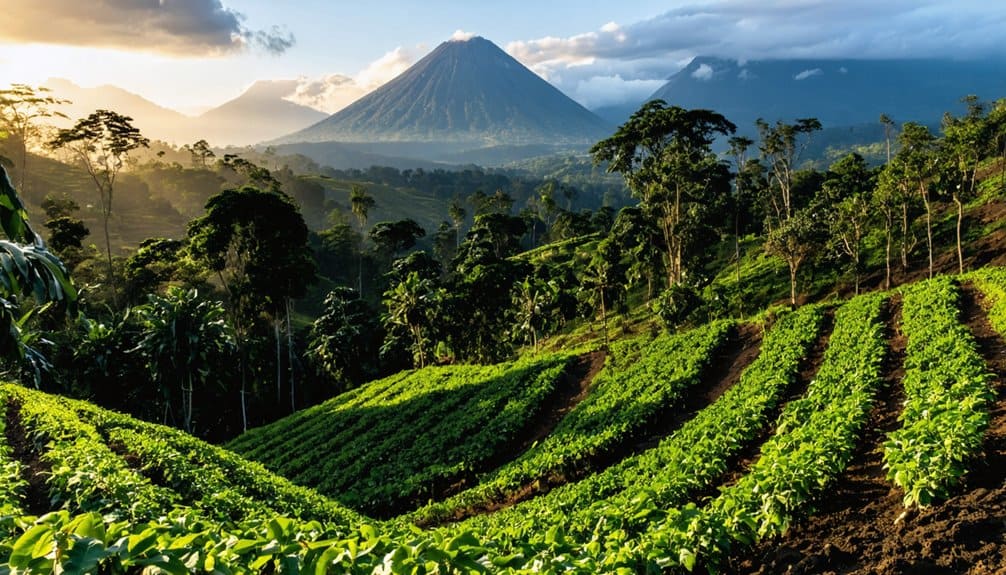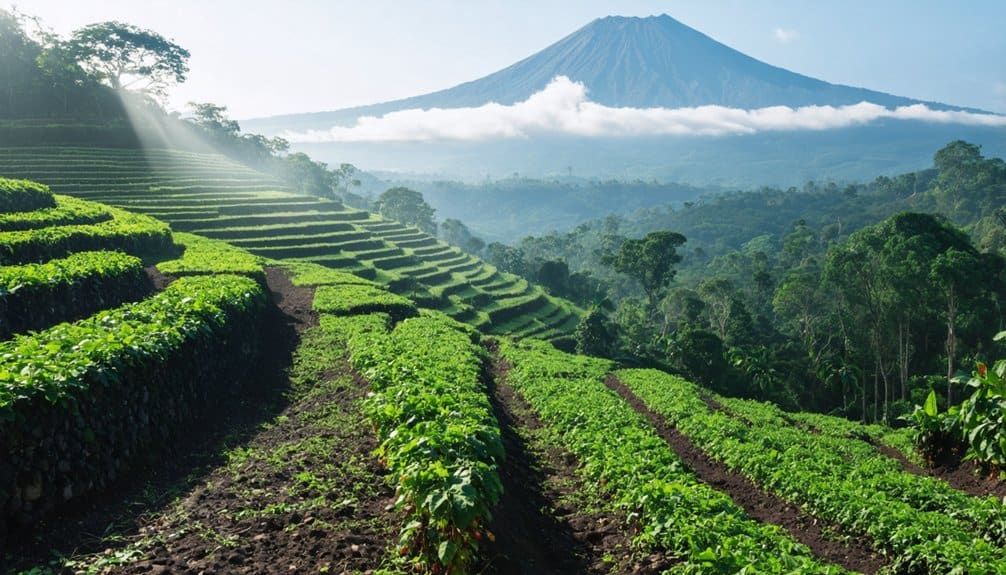You’ll find Guatemala’s Antigua Valley creates the perfect coffee-growing environment thanks to its three guardian volcanoes: Agua, Fuego, and Acatenango.
These volcanic sentinels maintain ideal temperatures between 66-71°F while enriching the valley’s Andisol soils with mineral-rich ash deposits.
The volcanic pumice regulates moisture levels, while the 4,600-5,600 feet elevation creates optimal stress conditions.
This unique terroir holds even more secrets to its exceptional coffee production.
Key Takeaways
- Three active volcanoes (Agua, Fuego, and Acatenango) enrich the soil with mineral-rich ash and create unique growing conditions.
- The valley maintains ideal year-round temperatures between 64-72°F with 65% humidity for optimal coffee growth.
- Volcanic pumice in the soil provides excellent drainage and moisture regulation, compensating for relatively low rainfall.
- Perfect elevation range of 4,600-5,600 feet creates stress conditions that enhance coffee flavor development.
- Rich volcanic Andisol soils contain high levels of potassium and phosphorus, supporting superior root development and cherry formation.
The Volcanic Guardian: How Three Mountains Shape Antigua’s Coffee

Three volcanic giants – Agua, Fuego, and Acatenango – stand as ancient guardians of Guatemala’s Antigua Valley, creating a unique terroir for coffee cultivation.
You’ll find this volcanic trinity provides more than just scenic beauty.
Their presence creates a specialized microclimate, maintaining temperatures between 66-71°F, while active Fuego regularly deposits mineral-rich ash that enriches the soil.
The volcanic pumice beneath your coffee plants acts as a natural moisture regulator, compensating for the region’s low rainfall.
Together, these conditions create an environment where your coffee develops complex flavor profiles, thriving at elevations between 4,600-5,600 feet.
These exceptional growing conditions consistently produce bright acidity and full body in Antigua’s high-quality arabica beans.
Nature’s Perfect Recipe: Climate and Elevation Harmony
When you investigate Antigua Valley’s distinctive coffee-growing conditions, you’ll find a precise harmony of climate variables that create an ideal environment for arabica cultivation.
At 4,600-5,600 feet elevation, you’re positioned in a sweet spot where temperature and humidity remain remarkably stable year-round.
The region’s coffee plantations thrive under the watchful presence of three majestic volcanoes, creating a unique microclimate for cultivation.
Your coffee benefits from four critical environmental factors:
- Consistent 64-72°F temperatures
- 65% humidity levels
- Well-defined seasonal patterns
- 32-48 inches of annual rainfall
This perfect recipe of elevation and climate creates stress conditions that force coffee plants to develop slowly, concentrating flavors and producing exceptional beans that you’ll recognize as distinctly Antiguan.
Rich Volcanic Soils: The Foundation of Excellence

The volcanic foundation of Antigua Valley creates an extraordinary environment for coffee cultivation, where nutrient-rich Andisol soils form the bedrock of excellence.
You’ll find your coffee thriving in volcanic loam enriched by Fuego’s continuous ash deposits, delivering vital minerals daily.
The region’s three surrounding volcanoes contribute to the area’s exceptional growing conditions.
| Soil Component | Benefit to Coffee |
|---|---|
| Volcanic Ash | Mineral Enrichment |
| Andisol | Nutrient Retention |
| Pumice | Moisture Control |
| Potassium | Root Development |
| Phosphorus | Cherry Formation |
This distinctive soil composition creates your perfect growing medium, featuring optimum drainage and mineral availability.
These conditions, combined with high-altitude cultivation between 1500-2000 masl, guarantee your coffee develops complex flavor profiles characterized by bright acidity and full body.
Traditional Cultivation Methods in the Valley
Traditional cultivation methods in Antigua Valley reflect generations of agricultural wisdom, where you’ll find shade-grown coffee plants thriving between 600-2,000 meters above sea level.
These time-tested practices enhance the region’s volcanic soil potential through strategic canopy management.
The valley’s coffee production is overseen by ANACAFÉ’s quality controls to maintain the highest standards.
Your fellow farmers in the valley follow these crucial cultivation protocols:
- Planting under native shade trees to create ideal microclimates
- Hand-selecting only red-purple cherries during December-April harvest
- Maintaining small-scale, family-owned plots within cooperative networks
- Utilizing centralized processing facilities with solar energy systems
This meticulous approach, combined with predictable weather patterns, guarantees consistently exceptional bean development.
From Bean to Cup: Processing Excellence in Antigua

Processing excellence in Antigua Valley stems from a meticulous wet-processing system that capitalizes on the region’s high humidity levels and volcanic terroir.
You’ll find that ANACAFÉ’s stringent quality control guarantees every bean meets Strictly Hard Bean standards, grown above 4,000 feet in mineral-rich soil.
The wet processing method you’re witnessing here improves the coffee’s bright acidity while preserving the characteristic chocolate and caramel notes.
When combined with the valley’s unique microclimate between three volcanoes, this process creates the velvety mouthfeel you’ve come to expect from Antigua coffee.
Each cup tells the story of careful fermentation and controlled drying.
The wet processing predominates throughout Guatemala due to its consistently high humidity levels.
FAQs
How Do Local Coffee Farmers Adapt to Potential Volcanic Hazards?
You’ll adapt by shaking ash from plants, implementing wet processing methods, positioning crops at strategic elevations, selecting diverse coffee varieties, and utilizing volcanic soil’s mineral enrichment while maintaining vigilant monitoring systems.
What Economic Challenges Do Small-Scale Antigua Coffee Producers Face Today?
While you’d expect high-quality Antigua coffee to command premium prices, you’re facing unsustainable market rates below $110 per quintal, rising production costs, climate-driven crop losses, and devastating labor shortages.
How Does Tourism Impact Coffee Production in the Antigua Valley?
You’ll find tourism directly improves coffee production by creating supplementary revenue streams, fostering sustainable farming practices, supporting local farmers’ education, and enabling market access through direct-to-consumer sales during farm visits.
Which Coffee Certification Programs Are Most Common Among Antigua’s Farmers?
You’ll find Organic and Rainforest Alliance certifications dominate Antigua’s farms, as these programs align with the region’s volcanic soil management practices and established shade-grown coffee cultivation methods.
What Sustainable Farming Practices Are Being Adopted by Antigua Coffee Producers?
You’ll find Antigua’s producers implementing top working grafting, volcanic soil enrichment, shade-grown cultivation, composting systems, and diverse tree planting while conducting regular soil analyses to maintain ideal growing conditions.
The Bottom Line
You’ll find Antigua’s coffee excellence lies in the stark contrasts: mineral-rich tephra meets organic matter, while diurnal temperature variations stress the cherries to perfection.
The valley’s Andisol soils, derived from volcanic ash, boast exceptional phosphorus retention and water-holding capacity.
Between Volcán de Agua’s basaltic deposits and Acatenango’s pumice layers, you’re witnessing a living laboratory of geological coffee cultivation at its finest.
